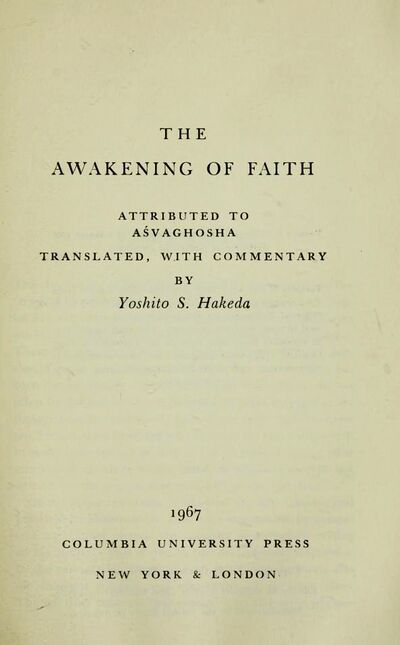No edit summary |
No edit summary |
||
| Line 31: | Line 31: | ||
********{{i|(a) Purity of Wisdom|41}} | ********{{i|(a) Purity of Wisdom|41}} | ||
********{{i|(b) Suprarational Functions|41}} | ********{{i|(b) Suprarational Functions|41}} | ||
(3) The Characteristics of the Essence of | *******{{i|(3) The Characteristics of the Essence of Enlightenment|42}} | ||
Enlightenment | ******{{i|b. The Aspect of Nonenlightenment|43}} | ||
b. The Aspect of Nonenlightenment | ******{{i|c. The Relationships Between Enlightenment and Nonenlightenment|45}} | ||
c. The Relationships Between Enlightenment and | *******{{i|(1) Identity|45}} | ||
Nonenlightenment | *******{{i|(2) Nonidentity|46}} | ||
(1) Identity | *****{{i|2. The Cause and Conditions of Man’s Being in Samsara|46}} | ||
(2) Nonidentity | ******{{i|a. Mind|47}} | ||
2. The Cause and Conditions of Man’s Being in | ******{{i|b. Consciousness|49}} | ||
******{{i|c. Defiled States of Mind|51}} | |||
a. Mind | ******{{i|d. Comments on the Terms Used in the Foregoing Discussion|52}} | ||
b. Consciousness | |||
c. Defiled States of Mind | |||
d. Comments on the Terms Used in the Foregoing | |||
Discussion | |||
3. The Characteristics of Beings in SaÅs1ra 57 | 3. The Characteristics of Beings in SaÅs1ra 57 | ||
a. Permeation of Ignorance 59 | a. Permeation of Ignorance 59 | ||
Revision as of 16:47, 31 July 2020
The text known as the Dasheng qixinlun (Awakening of Faith in the Mahāyāna) is a short treatise occupying only nine pages in the Taishō edition of the Chinese Tripitaka.[1] The reconstructed Sanskrit title of the work is Mahāyāna-śraddhotpāda-śāstra; it is said to have been written in Sanskrit by Aśvaghosha and translated into Chinese in A.D. 550 by the famous Indian translator of Buddhist texts, Paramārtha. No Sanskrit version of the text exists today, however, and all our knowledge of the work is based on this Chinese version and a second version that dates from a somewhat later period.
The work is a comprehensive summary of the essentials of Mahāyāna Buddhism, the product of a mind extraordinarily apt at synthesis. It begins with an examination of the nature of the Absolute or enlightenment and of the phenomenal world or nonenlightenment and discusses the relationships that exist between them; from there, it passes on to the question of how man may transcend his finite state and
participate in the life of the infinite while still remaining in the midst of the phenomenal order; it concludes with a discussion of particular practices and techniques that will aid the believer in the awakening and growth of his faith. In spite of its deep concern with philosophical concepts and definitions, therefore, it is essentially a religious work, a map drawn by a man of unshakable faith, which will guide the believer to the peak of understanding. But the map and the peak are only provisional symbols, skillful and expedient ways employed to bring men to enlightenment. The text and all the arguments in it exist not for their own sake but for the sake of this objective alone. The treatise is, indeed, a true classic of Mahāyāna Buddhism. (Hakeda, introduction, 1–2)
| Citation | Hakeda, Yoshito S., trans. The Awakening of Faith: Attributed to Aśvaghosha. New York: Columbia University Press, 1967. |
|---|---|

